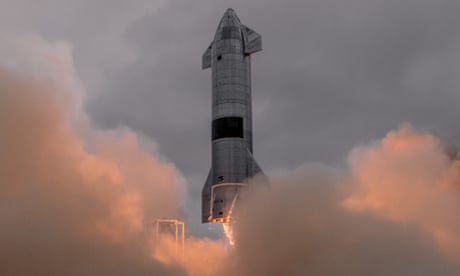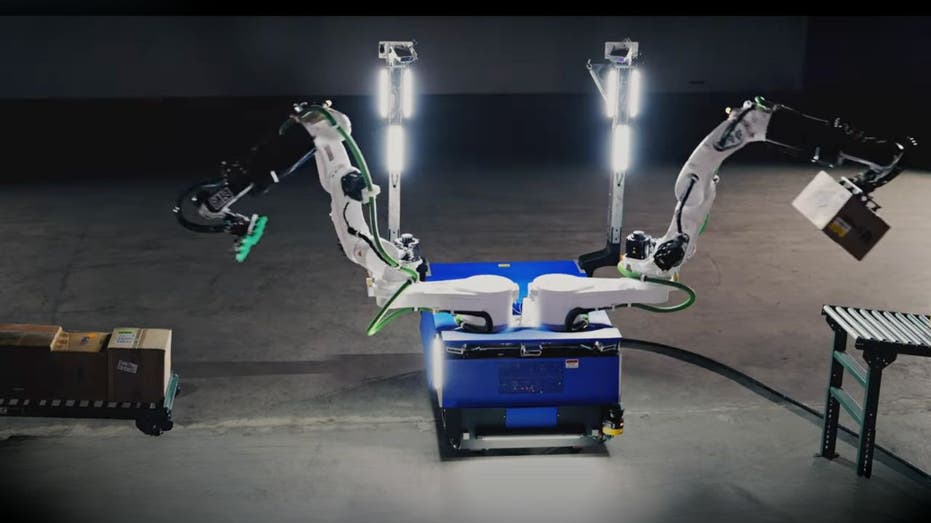- by foxnews
- 08 Apr 2025
SpaceX?s towering Starship aims to get humans to Mars
SpaceX’s towering Starship aims to get humans to Mars
- by theguardian
- 22 Dec 2021
- in technology

It's been an eventful month for Elon Musk. The world's richest man and founder of Tesla and SpaceX was, controversially, named Time's person of the year; became embroiled in a Twitter spat over his taxes with a politician he branded "Senator Karen" and got a bizarre new haircut after splitting with his girlfriend, the pop singer Grimes.
Next month, however, or perhaps a few weeks beyond if the attendant gremlins of spaceflight choose to play with the launch schedule, could come an achievement to surpass anything Musk has done before.
The first orbital test launch of the largest and most powerful rocket ship ever to leave Earth - SpaceX's towering Starship, from its Starbase headquarters in Texas - is seen by many as a pathway back to the moon for the first time in half a century and maybe the first vehicle to eventually land humans on Mars.
The project that began life in Musk's overactive mind more than a decade ago is every bit as ambitious as his pronouncement this week that: "I'll be surprised if we're not landing on Mars within five years."
Starship will be the first spacecraft in which all components are fully reusable, reducing significantly the traditionally astronomic costs of space travel. It has an unprecedented in-flight refueling capacity, allowing for more frequent and efficient operations.
As the visionary behind the return to human spaceflight from US soil last year for the first time since the retirement of Nasa's shuttle fleet in 2011, Musk, 50, is confident that his 395ft (120m) spacecraft, a full 32ft taller than the Apollo-era Saturn V, can deliver.
Time magazine, in honoring the billionaire entrepreneur, appeared to acknowledge that humankind's greatest achievements come from unorthodox minds. Musk, it said, is "a madcap hybrid of Thomas Edison, PT Barnum, Andrew Carnegie and Watchmen's Doctor Manhattan, the brooding, blue-skinned man-god who invents electric cars and moves to Mars."
Sean O'Keefe, a former head of Nasa, said Musk had repeatedly challenged the traditional rules of spaceflight with great success.
"One of the things that [he] has artfully figured out how to do is, whenever there has been any doubt about his ability to accomplish something, in some period of time thereafter, he has focused his attention, expertise and talent to go out and demonstrate that you can do it," O'Keefe, professor of strategic management and leadership at Syracuse University, told the Guardian.
"And that's what this is. It is going to be interesting to see where this goes. [Starship] provides options, very significant options.
"To look at, for example, the lunar surface as being not only reachable by multiple means but also by commercial sources that can do the regular resupply and so forth, will be extremely beneficial."
Starship will be propelled into orbit by a first-stage booster rocket called Super Heavy, to which SpaceX attached 29 of its Raptor engines before sending the entire craft to the launchpad at its Starbase launchpad this week. With about 16m pounds of thrust, and a capacity to lift up to 165 tons from the Earth's surface, Starship is almost twice as powerful as the Saturn V rockets that sent 12 astronauts to the moon between 1969 and 1972.
"You can really take advantage of the Starship architecture and get to the outer solar system in ways we haven't thought about before," Jennifer Heldmann, a planetary scientist at Nasa's Ames research center in California, told Arstechnica. "It could provide a revolutionary new way of exploring these worlds."
Other innovative and speculative uses have been proposed for the new spacecraft, including asteroid-busting missions to protect Earth.
Musk, though, has made no secret of his ambitions to reach the moon and one day colonize Mars to make humans a multi-planetary species.
"The next really big thing is to build a self-sustaining city on Mars and bring the animals and creatures of Earth there," he told Time. "Sort of like a futuristic Noah's ark. We'll bring more than two, though, it's a little weird if there's only two."
First, however, astronauts must return to the moon and Starship is only one of two spacecraft in production with the capability to land astronauts back there. Nasa's own space launch system (SLS), part of the Artemis program, has suffered budget overruns and delays in development, pushing back its first crewed landing until at least 2025.
SpaceX also has a hand in Artemis, having won the $2.9bn Nasa contract to build its lunar lander and sparking a lawsuit with rival Jeff Bezos's Blue Origin company that was settled in Musk's favor last month.
No firm date has been set in January for Starship's orbital test launch, which follows a series of increasingly successful suborbital flights from Texas over the last two years. If successful, Musk has said up to a dozen further flights could follow in 2022, with Starship's first lunar voyage - a space tourism venture funded by Japanese billionaire Yusaku Maezawa - set for 2023.
O'Keefe, meanwhile, remains cautious about Starship's deeper-space capabilities for humans, despite its size and innovation, given that it relies on the same chemical propulsion systems used in spaceflight "since Yuri Gagarin took the first trip and Alan Shepard was right behind him" in 1961.
"Mars is 65m miles away," he said. "'Cutting' the distance can only be achieved if you add space propulsion and right now we have none of that. We have no means to achieve it. No one on this rock knows how to do that.
"The second thing we don't have is the means to provide shielding sufficient to preserve human life. As it stands, the radioactivity is so extraordinary you wouldn't make it, much less get back. Those are the two fundamental limitations I see to anyone being able to achieve anything much beyond the lunar objective at this stage."
- by foxnews
- descember 09, 2016
Ancient settlement reveals remains of 1,800-year-old dog, baffling experts: 'Preserved quite well'
Archaeologists have recently unearthed the remarkably well-preserved remains of a dog from ancient Rome, shedding light on the widespread practice of ritual sacrifice in antiquity.
read more





